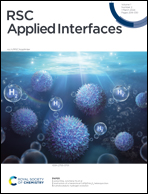Synthesis of a MOF-derived magnetite quantum dots on surface modulated reduced graphene oxide composite for high-rate lithium-ion storage
Abstract
As an anodic candidate material for lithium-ion batteries (LIBs), magnetite (Fe3O4) has the advantages of high theoretical capacity (926 mA h g−1), environmental friendliness, and natural abundance. The critical problems of inferior rate capability and cycling stability for Fe3O4 anodes need to be urgently solved. In this work, a composite anode material with Fe3O4 quantum dots immobilized by pyrolytic carbon and reduced graphene oxide skeleton (Fe3O4 QDs@C/RGO) is rationally engineered from a metal–organic framework (MOF) domain on surface-modulated RGO precursor. The involved raw materials are 1,3,5-benzenetricarboxylic acid (C9H6O6, trimesic acid, H3BTC), tea polyphenol (TP), few-layered graphene oxide (GO) and metal iron (Fe) foils, which react in mild hydrothermal condition in the synthesis of the Fe-BTC/TP-RGO precursor sample. The essence of the reactions has been uncovered, and the Fe3O4 QDs@C/RGO composite shows excellent lithium-ion storage capability with a reversible capacity of 1070.84 mA h g−1 after 150 cycles at 200 mA g−1, 738.03 mA h g−1 after 300 cycles at 1000 mA g−1 in half cells, and 717.29 mA h g−1 after 150 cycles at 200 mA g−1 in full cells. The sample synthesis protocol has the merits of simplicity and eco-friendliness, and the Fe3O4 QDs@C/RGO sample can be regarded as a promising anodic candidate for high-performance LIBs.

- This article is part of the themed collections: Sustainable Development Goal 12: Responsible Production and Consumption, Sustainable Development Goal 7: Affordable and Clean Energy and RSC Applied Interfaces HOT Article Collection


 Please wait while we load your content...
Please wait while we load your content...